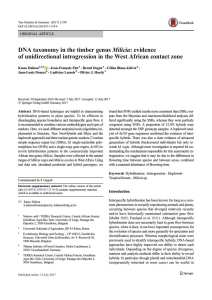Daïnou K., Flot J.F., Degen B., Blanc-Jolivet C., Doucet J.L., Lassois L., Hardy O.J.
DNA-based techniques are helpful in characterising hybridisation patterns in plant species. To be efficient in disentangling species boundaries and interspecific gene flow, it is recommended to combine various methodologies and types of markers. Here, we used different analytical tools (algorithms implemented in Structure, Tess, NewHybrids and HIest, and the haploweb approach) and three nuclear geneticmarkers (7 nuclear simple sequence repeat loci (SSRs), 62 single-nucleotide polymorphism loci (SNPs) and a single-copy gene region, At103) to revisit hybridisation patterns in the commercially important African tree genus Milicia. Samples were collected in the natural ranges of Milicia regia and Milicia excelsa inWest Africa. Using real data sets, simulated purebreds and hybrid genotypes, we found that SNPs yielded results more consistent than SSRs; outputs from the Bayesian and maximum-likelihood analyses differed significantly using the SSRs, whereas they were perfectly congruent using SNPs. A proportion of 12.4% hybrids were detected amongst the SNP genotype samples. A haploweb analysis of At103 gene sequences confirmed the existence of interspecific hybrids. There was also a clear evidence of advanced generations of hybrids (backcrossed individuals) but only towards M. regia. Although more investigation is required for understanding the mechanisms responsible for this asymmetric introgression, we suggest that it may be due to the differences in flowering time between species and between sexes, combined with a maternal inheritance of flowering time.
Consultez la notice complète de l’article sur ORBi

